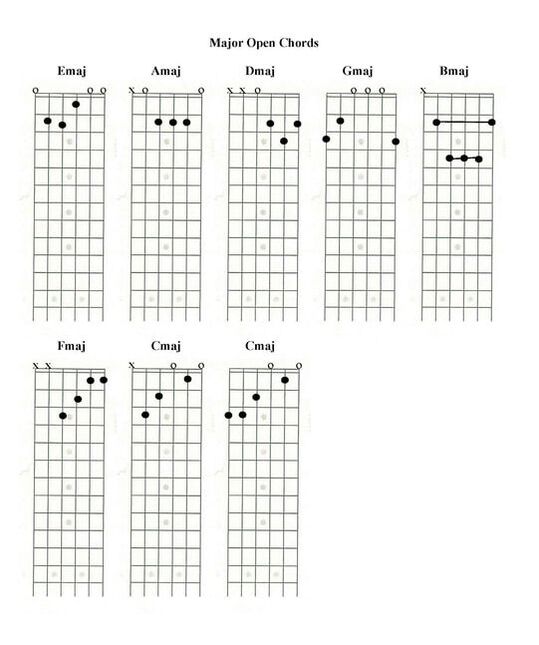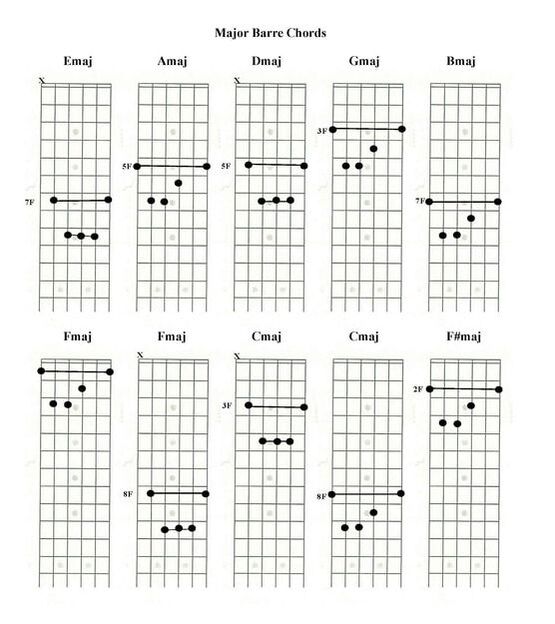major chords
Theory
A chord is a group of notes played "simultaneously." (It isn't truly simultaneous - like it would be on a piano - because all six strings are not struck at the same time when you strum.) A simple chord consists of the root (the main tone note), the fifth, and the third. A major third is "sharpened", i.e. the note is played one fret higher than the true third. For example, if you take an E and count up five notes (E-F-G-A-B), you reach the fifth: B. The third note sharpened becomes G#. Thus, an E major consists of E, B, & G#. When you look at the Emaj diagramed below, you'll see those are the only three notes played, including on the unfretted strings. (The diagrams are easier to read as separate files pages [PDF].)
A chord is a group of notes played "simultaneously." (It isn't truly simultaneous - like it would be on a piano - because all six strings are not struck at the same time when you strum.) A simple chord consists of the root (the main tone note), the fifth, and the third. A major third is "sharpened", i.e. the note is played one fret higher than the true third. For example, if you take an E and count up five notes (E-F-G-A-B), you reach the fifth: B. The third note sharpened becomes G#. Thus, an E major consists of E, B, & G#. When you look at the Emaj diagramed below, you'll see those are the only three notes played, including on the unfretted strings. (The diagrams are easier to read as separate files pages [PDF].)
We're looking at some basic open chords and their related barre chords. Open chords, as the name implies, include open (or unfretted) strings and are played in the first position at the top of the neck near the nut. Since open chords don't require you to fret all six strings, they are easier to play and where you should start, especially if you're learning on acoustic. Those open strings also make the top vibrate more, thus open chords ring out and are more resonant. (Technically, I've diagramed a barre chord for the B because I've found beginners find a true open B to be difficult, and this chord gives a relatively easy introduction to barre chords.)
Looking at the Major Open Chords diagram [PDF], you'll notice a number of symbols. The black dots are where your fingers go. A string with an "o" at the top means that string is played; if there's an "x", that string is not strummed. So, which fingers do you use for which chords? While there is a "proper" method, you should use whichever fingers are most comfortable. I advise this because the rule is broken all the time for various reasons. For example, an Amaj is "properly" played with the index (1st), middle (2nd), & ring (3rd) fingers, but I have difficulty squeezing those fingers into that small of a space, so I use my 2nd, 3rd, & 4th, or I simply barre the second fret and mute the first string. A player may also change their regular fingering to make transitions in a particular song easier. I might change how I'm fretting a G if the song requires frequent shifts to C & F.
Exercises
We've reached the point where practice takes over if you want to make progress. Select three chords to practice. If you lean toward rock'n'roll, I suggest A, D, & E. For country, I'd pick G, C, & D. First, practice carefully placing your fingers so all six strings ring out. As you get better at this, practice releasing the strings and replacing your fingers. When you begin to master each chord individually, practice rotating between your three chords. As you do, you'll likely start hearing song-like harmonies since both sets of chords reflect a I, IV, V pattern. Eventually, switch to the other set of chords and learn them as well, then combine the sets in whatever rotation sounds good. Don't avoid the chords that are more difficult for you. You are building fretboard awareness and finger strength and dexterity along with learning the chords themselves with these exercises [PDF]. (As you get good at this, you can jump ahead to the Reading tablature page if you want to start playing some simple songs. For now, don't worry about any minor or 7th chords, just play them as majors.)
We've reached the point where practice takes over if you want to make progress. Select three chords to practice. If you lean toward rock'n'roll, I suggest A, D, & E. For country, I'd pick G, C, & D. First, practice carefully placing your fingers so all six strings ring out. As you get better at this, practice releasing the strings and replacing your fingers. When you begin to master each chord individually, practice rotating between your three chords. As you do, you'll likely start hearing song-like harmonies since both sets of chords reflect a I, IV, V pattern. Eventually, switch to the other set of chords and learn them as well, then combine the sets in whatever rotation sounds good. Don't avoid the chords that are more difficult for you. You are building fretboard awareness and finger strength and dexterity along with learning the chords themselves with these exercises [PDF]. (As you get good at this, you can jump ahead to the Reading tablature page if you want to start playing some simple songs. For now, don't worry about any minor or 7th chords, just play them as majors.)
Once you build up finger strength, it's time to try barre chords. (This will come faster if you're learning on electric.) Barre chords can convey more power than open chords. In essence, a barre is when you lay your index finger across all six strings and press them down creating a new overall string length - a new nut, if you will. Take a look at the Amaj on the barre diagram [PDF]. The index finger is at the fifth fret and presses down the sixth, second, and first strings - the chords tones of A, E, & A respectively. The other three strings are fretted exactly like an open Emaj, which makes sense if you look at the barre as a new nut. If you look at all the barre chords I've diagramed, you'll see a clear pattern: chords including the sixth string are shaped like an open E, and chords without the sixth string look like an open A.
Fingering is more standard for barre chords than open chords. For barre chords including the low E string, the index finger barres, the middle finger plays the third, the ring finger takes the fifth, and the pinky plays the root again. For chords starting on the low A string, the index finger barres, and the ring finger applies a second barre two frets up the neck.
Practice both barre shapes up and down the neck. As you gain more strength and confidence, incorporate open chords with barre chords.

